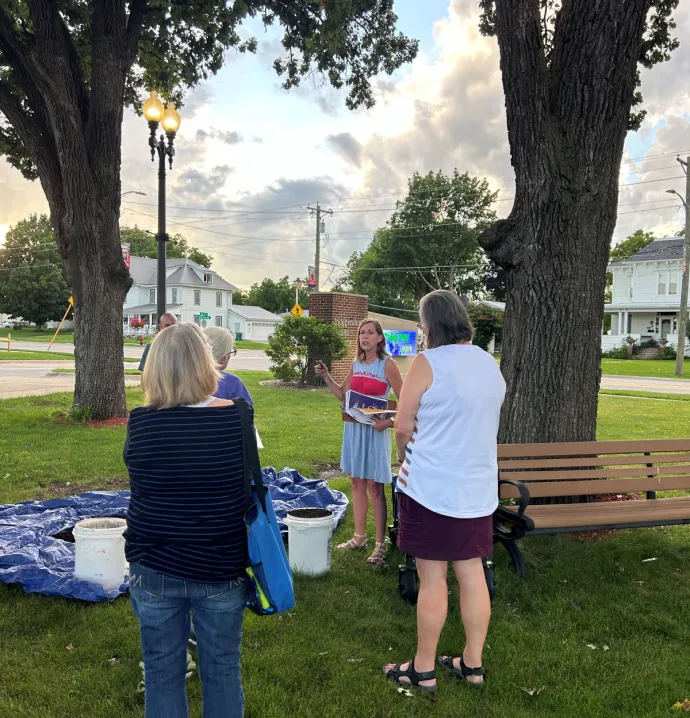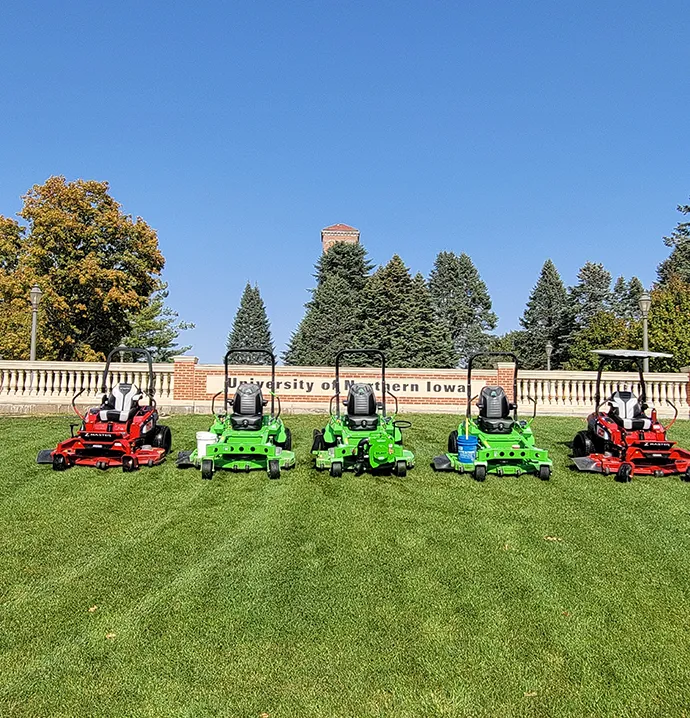Helping save the monarch butterfly
Helping save the monarch butterfly
Like many elementary students in the Midwest, Gretchen Steffensmeier vividly remembers hatching monarch butterflies in milkweed-stuffed glass jars.
It was one of the reasons Steffensmeier, now a senior biology major at the University of Northern Iowa, became fascinated with conservation and ecology. Now, years after watching the life cycle of the monarch unfold in her classroom, Steffensmeier is one of four UNI students taking part in field research operated out of UNI’s Tallgrass Prairie Center to help prevent the rapid decline of the insect by investigating best practices in establishing the habitat the butterfly needs to reproduce.
“Monarchs are such an iconic species for the Midwest, and they are kind of like a gateway into the world of ecology and conservation for a lot of people at a young age,” Steffensmeier, 22 of Urbandale, said. “But now, monarch populations are decreasing.”
Monarch populations have been declining in the Midwest since the late 1990s, in large part due to the increased use of herbicide on corn and soybean fields that prevent the growth of milkweed - the monarch’s only source of food during the caterpillar stage and the only plant a monarch butterfly will lay eggs on.
“You could say that Iowa has lost almost 26 million acres of monarch habitat since the turn of the century,” said Laura Jackson, director of the Tallgrass Prairie Center, referencing the total amount of acres of corn and soybeans planted in the state that are now virtually milkweed-free.
A federal program, the Conservation Reserve Program (CRP), could play a critical role in monarch recovery. The program, administered by the U.S. Department of Agriculture’s Farm Service Agency, offers farmers a yearly rental payment to remove environmentally sensitive land from agricultural production and plant species that will improve environmental health and quality.
The Tallgrass Prairie Center’s work this summer will examine the success of habitat restoration efforts for farmers at the end of their 10-year CRP contracts.
“It’s about seeing how well public money is being spent and how good of a job we’re doing to enhance habitat quality,” Jackson said. “This work is important, because we want our government conservation programs to work well, and to do what they're intended to do.”
The team, which includes Steffensmeier, senior biology major Schuyler Hop, UNI alum Pryce Johnson and graduate student Tristan Murphy, start their days around 6 a.m., traveling up to 90 minutes to visit one of the 15 sites in northeastern Iowa they surveyed over a 10-week period this summer.
Once they arrive on the site, the team splits into pairs to complete surveys cataloguing the plant species in 100, one-square-meter areas that were predetermined randomly. The survey results are brought back to the lab at the Tallgrass Prairie Center and analyzed, so researchers can observe the presence of plants monarch butterflies prefer, such as milkweed, or the plants they don’t, such as smooth brome, an invasive species of grass common in degraded prairies.
The initial data collection is part of a study that will examine if conservation practices put into place this summer will have an impact next year. Jackson will summarize the summer’s research in a grant report to the Farm Service Agency at the end of the year.
The days can be grueling. Jackson remembers seeing the group stumble back to the lab one afternoon with their ankles covered in ant bites. Hop recalled one particularly hot day where he was handling a mysterious plant in his quadrant that turned out to be poison ivy (luckily, no one developed a rash). But the work is rewarding, not just because of the experience conducting research, but because the data they collect could help protect a vital ecosystem in decline - the native prairie.
“This work is the first step to understanding and managing the environment in impactful ways for the future,” Hop, 22, from Ames, said. “The tallgrass prairie is an ecosystem that has been massively reduced and distorted and is something we need to protect. I find it very fulfilling that our work has a tangible impact on conservation research and practices and hope that work I do in the future will continue to impact environmental management or community involvement in conservation.”
Beyond providing habitat for monarch butterflies, the prairie is also home to other insects and burrowing creatures, including bumblebees. The deep roots of native prairie plants and grasses can also mitigate many of the water quality problems that plague the state, such as tainted agricultural runoff and flooding.
And the research experience the students gain this summer - how to avoid confirmation bias, how to make sure research and results are repeatable, how to organize and evaluate data - will be valuable no matter what discipline of science they pursue.
For Steffensmeier, this summer’s research will be a stepping stone in her ultimate goal of becoming a college professor in either plant ecology or conservation.
“I also find this work fulfilling,” she said. “Because I know that even though my impact is small, it can still make a difference in the long run and could possibly help improve conservation practices in the future.”




